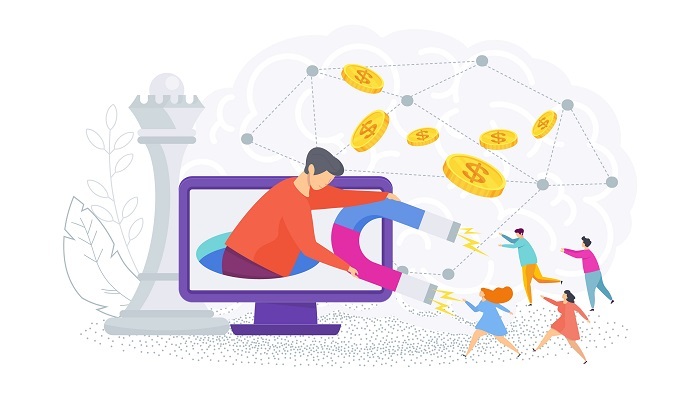
 Data Structure
Data Structure Networking
Networking RDBMS
RDBMS Operating System
Operating System Java
Java MS Excel
MS Excel iOS
iOS HTML
HTML CSS
CSS Android
Android Python
Python C Programming
C Programming C++
C++ C#
C# MongoDB
MongoDB MySQL
MySQL Javascript
Javascript PHP
PHP
- Selected Reading
- UPSC IAS Exams Notes
- Developer's Best Practices
- Questions and Answers
- Effective Resume Writing
- HR Interview Questions
- Computer Glossary
- Who is Who
Marketing Model Through Market Sensing and Learning
We are in a revolutionary era where more modern methods of thinking are challenging traditional ways of thinking about economics, business, and almost every aspect of life.
The days of firms and marketers having certainty about the market and consumer preferences and tastes are long gone. Instead, the market we currently live in is one that is constantly evolving, making the capacity to adapt to these changes a requirement for success.
In this context, it is important to note that those post facto responses, which have been the hallmark of marketing until now, are no longer sufficient for corporate survival. Instead, organizations must anticipate what customers will desire and understand their mindsets. This indicates that marketers should climb up the value chain and concentrate on value-based marketing rather than transactional, brand, or relationship marketing.

Market Sensing and Learning: What Are They?
Market sensing and learning is the first step in developing a strategy for turning the company into a fiercely competitive one that doesn't just follow trends but establishes them or is a trailblazer in its own right.
The key takeaway from this is that businesses need to be "psychic" in order to survive in today's fiercely competitive market. This means that they must learn to read customers' minds in order to predict what they will want next, as was discussed in the previous section.
Growth Detection Using Market Sensors
Additionally, market sensing contributes to an organization's ongoing improvement by facilitating easy consumer connection. In the current business environment, one of the main concerns is the measurement of client attitudes. In order to provide customers with value-added services and goods, the requirements of the customers should be gathered and translated into a number of characteristics. This is possible through efficient market sensing (Kordupleski R, 2003).
Market sensing aids in not only identifying current customers but also in understanding rivals, outside forces that may affect a corporation in the future, and other things. With the use of market sense, a company can better understand the market and shed its erroneous assumptions about the wants of its clients.
Creating Value for Customers Through Market Awareness
Without improvements, a single good or service cannot survive on the market for many years. A product needs to evolve and adapt to continue being used by consumers. Companies like Godrej, Dabur, Britannia, and ITC, which were founded more than a century ago, are still in business today thanks to their creative approach to creating value for customers (Madaan, 2009). In contrast, goods like Pepsi's Crystal Pepsi, Microsoft's Zune and WebTV, Apple's Pippin, and McDonald's Archdeluxe are only a few instances of the worst failures in the market as a result of improper understanding of consumers (Kazmi, 2008).
We have seen how the first step in developing a road toward a market strategy based on customer value is market sensing and learning. The ability to offer value to the customer, which is the overarching goal of the strategic transformation that businesses seek in today's environment, must be taken into account once firms have a firm understanding of the consumer and the market.
Businesses can move beyond reacting to shifting market conditions and instead anticipate what will happen next and adjust their tactics once they have a thorough understanding of and a "knowing" of their customers.
The idea here is that boosting IQ encourages people to predict future trends, and increased intelligence enables better complexity analysis.
However, it should be noted that achieving market sensing and learning capabilities envisions a departure from conventional thinking. Marketers need to understand that emerging fields such as complexity and systems thinking must be harnessed to develop broad market sensing and learning capabilities.
Businesses can go on to the following steps of making strategic choices and actions that generate consumer value and propel their value-based marketing strategies once they are in a position to assess the market mood.
Conclusion
A capability to create value by comprehending complexity and consumer behavior is required in the tumultuous and chaotic 21st-century market since it goes beyond mechanistic patterns of thinking.
Only when the client's expectations are met or exceeded by the features of the product or the level of service provided are customer values generated. So, in order to do this, the first step is to understand what the customer expects, and then adjust the marketing techniques as necessary.
Businesses must have procedures in place to support them in this endeavor if they are to understand what the client's expectations are. Furthermore, the initial steps toward establishing these mechanisms that can help them in market sensing and learning.
The discussion thus far has shown that in order to produce customer value, one must first understand what the consumer wants. As businesses move into a phase where customer value is crucial rather than merely customer service, they must refocus their strategy.

